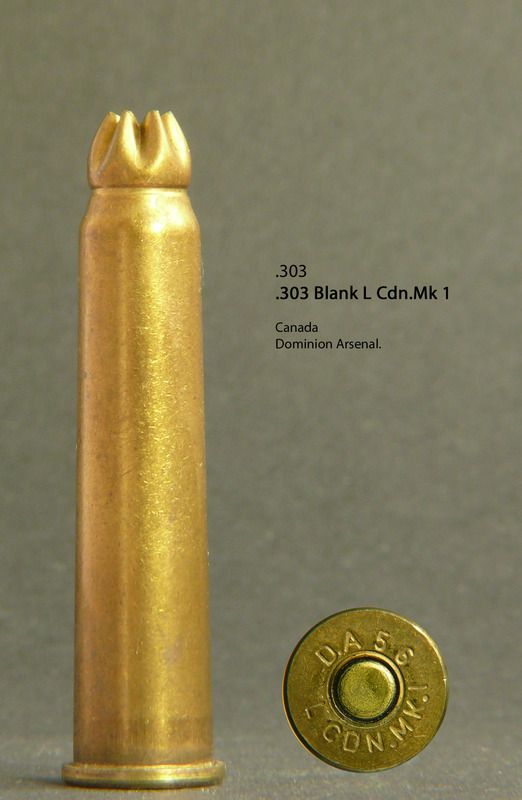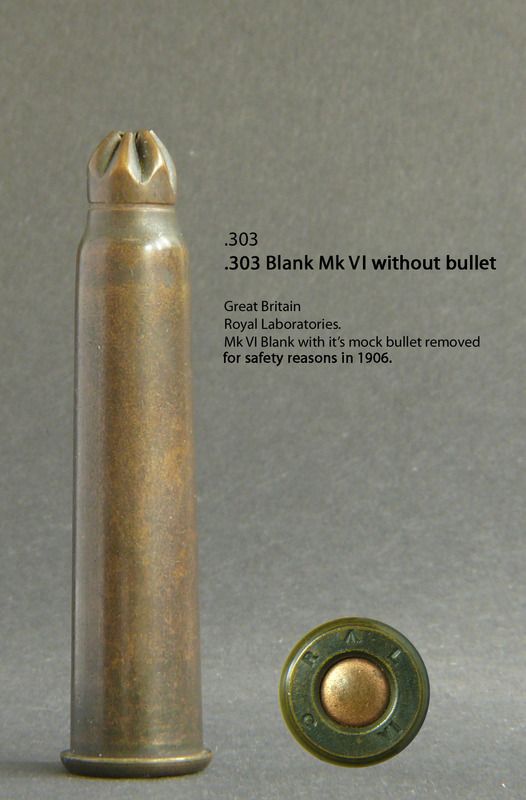British Ordnance Collectors Network
You are using an out of date browser. It may not display this or other websites correctly.
You should upgrade or use an alternative browser.
You should upgrade or use an alternative browser.
US made .303 blank
- Thread starter hangarman
- Start date
Gary,
To the best of my knowledge the US didn't make a .303 Blank for normal training purposes. I've checked through Hackley, Woodin & Scranton volume 1 which covers the period 1880-1939 and the only mention of blank production was a 1918 experimental trial to develop an ignition cartridge for the 6" Trench mortar. For the purposes of this trial 20,000 'special' blank cartridges were made by the United States Cartridge Co. These were loaded with 40gns of black powder. HWS doesn't show an illustration of any packaging so I would suggest none has survived.
Jim
To the best of my knowledge the US didn't make a .303 Blank for normal training purposes. I've checked through Hackley, Woodin & Scranton volume 1 which covers the period 1880-1939 and the only mention of blank production was a 1918 experimental trial to develop an ignition cartridge for the 6" Trench mortar. For the purposes of this trial 20,000 'special' blank cartridges were made by the United States Cartridge Co. These were loaded with 40gns of black powder. HWS doesn't show an illustration of any packaging so I would suggest none has survived.
Jim
Thanks Jim,
The reason for asking is I have a 15 dated US made .303 blank. Of course it is possible , probably highly likely , that its a post war manufacture using ww1 cases. I have attached a picture of the head stamp and a side view of the cartridge. Its reminiscent of the Mk1 blank produced by the Canadians in the '50s with a ring just below the crimp, presumably to support a wad.
Cheers
Gary
![IMG_20150831_092355[1].jpg IMG_20150831_092355[1].jpg](https://www.bocn.co.uk/data/attachments/93/93897-71aec2f22a9119502191e6d2995346b7.jpg)
![IMG_20150831_092425[1].jpg IMG_20150831_092425[1].jpg](https://www.bocn.co.uk/data/attachments/93/93898-5d04eae9f5b16be0776b73649249674e.jpg)
The reason for asking is I have a 15 dated US made .303 blank. Of course it is possible , probably highly likely , that its a post war manufacture using ww1 cases. I have attached a picture of the head stamp and a side view of the cartridge. Its reminiscent of the Mk1 blank produced by the Canadians in the '50s with a ring just below the crimp, presumably to support a wad.
Cheers
Gary
![IMG_20150831_092355[1].jpg IMG_20150831_092355[1].jpg](https://www.bocn.co.uk/data/attachments/93/93897-71aec2f22a9119502191e6d2995346b7.jpg)
![IMG_20150831_092425[1].jpg IMG_20150831_092425[1].jpg](https://www.bocn.co.uk/data/attachments/93/93898-5d04eae9f5b16be0776b73649249674e.jpg)
smle2009
Well-Known Member
Hi Gary,
that is a Mk VII ball case used to make a blank with,during WW1 and WW2 USA supplied us with ammunition but unfortunately most of it was condemned as sub standard and a lot of it was destroyed,so your example was most likely 'broken down' and the case re used as a blank,much the same as rejected UK cases were.
Tony
that is a Mk VII ball case used to make a blank with,during WW1 and WW2 USA supplied us with ammunition but unfortunately most of it was condemned as sub standard and a lot of it was destroyed,so your example was most likely 'broken down' and the case re used as a blank,much the same as rejected UK cases were.
Tony
Interesting cartridge....it obviously started life as a US-made Mk VII Ball but was then reloaded as a blank.
As you suggest it could well be a Canadian reload although I don't understand the need for the groove; other nations manufactured this style of blank without the need for a groove to support the wad.

Another possibility is that it's been reloaded as a British Mk VI Blank 'with its mock bullet removed'. These blanks also had the same groove just above the shoulder but this groove was put there to retain a dummy brass bullet. The dummy bullet was withdrawn from service in 1906 due to safety issues but blanks with the retaining groove continued to be issued. Your headstamp does seem a bit too late for this though.

My money's on Canadian!
Jim
As you suggest it could well be a Canadian reload although I don't understand the need for the groove; other nations manufactured this style of blank without the need for a groove to support the wad.

Another possibility is that it's been reloaded as a British Mk VI Blank 'with its mock bullet removed'. These blanks also had the same groove just above the shoulder but this groove was put there to retain a dummy brass bullet. The dummy bullet was withdrawn from service in 1906 due to safety issues but blanks with the retaining groove continued to be issued. Your headstamp does seem a bit too late for this though.

My money's on Canadian!
Jim
Attachments
Last edited by a moderator:
I never saw a Cart SA .303" Bulleted Blank L Mk 10Z with any kind of neck crimp.
The Mk 6 was a different kettle of fish to the Mk 10z The Mk 6 had an externally secured crimped extension in the profile of a Mk6 bullet. The Mk10z had a hollow wooden bullet stained blue. The Issue with the Mk 6 was that sometimes the extension would come off, which if happened in a Vickers machine gun would cause a stoppage that only an armourer could fix. To remedy this the extension was removed leaving the original crimped neck visible.
Hope that all makes sense.
Cheers
Gary
peashooter
BOCN Supporter
Right my 2 peneth, I have been following this because I actually have an unfired one of these. Now the Cartridge, S.A. Blank, .303-INCH, with mock bullet removed, Mark V.C. Solid case. Is what I have it down as BUT it should be a fully Blackened case "Page 23 Identification Manual .303 BA Temple" Now I thought MkIV with the mock bullet removed but they were obsolete by 1906 according to same said book. And to throw another spanner in the works mine isn’t Blackened and neither is the one in the picture from Hangerman it is just grubby and dirty not blackened "no offence to your blank there Hangerman" neither are Blackened cases so I am stumped on this one now. I had thought mine had just been cleaned or polished to remove the blackening but now I am not sure.
Rich
Rich
None taken Rich! And I thought I had asked a simple question.....I wondered if mine was blackened but its difficult to tell, apart from where the primer has been sealed with a clear sealant some of it over spilled on to the "US", thus showing the case was not blackened.
Did US made ball ammunition have crimped primers?
Cheers
Gary
Did US made ball ammunition have crimped primers?
Cheers
Gary
Cartridges for firing rifle grenades were fully blackened.
Was that in the '50s .303 H2 ?? I thought H1 were half blackened?
peashooter
BOCN Supporter
The amunition you find from WWI with the primers crimped in with the stabs are actually rounds that were sent to France but the French werent happy with them so they crimped in the primers and reloaded some of them wih AP bullets as well, I have one I will try and get a photo for you. WWII WRA .303 has the primers crimped in with 4 stabs but that was dome by WRA as standard. Saying that I do have a round WRA 1940 dated with no stab crimp
Rich
Rich
smle2009
Well-Known Member
Hi Rich,
not sure if your unfired blank is the same as Garys or a MkVI without mock bullet?, TonyE does list a example of a MkVI with mock bullet that has not been blackened,but is not the norm,in his .303 inch British Service Ammunition book.
The interesting thing about Garys blank is why it had a groove in the neck
Tony
not sure if your unfired blank is the same as Garys or a MkVI without mock bullet?, TonyE does list a example of a MkVI with mock bullet that has not been blackened,but is not the norm,in his .303 inch British Service Ammunition book.
The interesting thing about Garys blank is why it had a groove in the neck
Tony
This 'groove' has been debated previously....hopefully this link will open the previous discussion but it would seem that even TonyE didn't have an answer!
http://www.bocn.co.uk/vbforum/threads/54522-303-blank-question
Jim
http://www.bocn.co.uk/vbforum/threads/54522-303-blank-question
Jim




